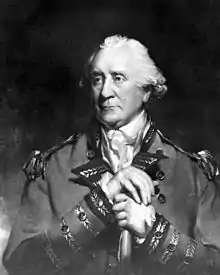Patrick Tonyn
Patrick Tonyn (1725–1804) was a British General who served as the last British governor of East Florida, from 1774 to 1783. His governorship lasted the span of the American Revolution. East Florida was a Loyalist colony during the war.
Patrick Tonyn | |
|---|---|
 General Patrick Tonyn | |
| 5th Governor of British East Florida | |
| In office 1 March 1774 – 12 July 1784 | |
| Preceded by | John Moultrie |
| Succeeded by | Vicente Manuel de Céspedes (Spanish East Florida) |
| Personal details | |
| Born | 1725 Berwick-upon-Tweed, Northumberland, England |
| Died | 30 December 1804 London |
| Profession | General and governor |
Early life
Patrick Tonyn was born in Berwick-upon-Tweed in Northumberland in 1725, into a military family. His father, Charles Tonyn, was a Colonel in the 6th Inniskillen Dragoons. Patrick Tonyn became a captain in the 6th Dragoons in 1751, with which regiment he served in Germany in 1758 during the Seven Years' War where, in 1759, the regiment fought at Minden and Wetter with great distinction. Tonyn was made lieutenant-colonel of the 104th Regiment of Foot in 1761.
Life in Florida and Revolution
Tonyn is generally described as a capable commander. During his tenure as governor of East Florida the colony enjoyed peace with the neighboring Indians, primarily due to his positive relationship with Ahaya the Cowkeeper, chief of the Alachua band of the Seminole tribe.
Like most favored British officers, Tonyn received a large grant in the new colony—a 20,000-acre (81 km2) tract in 1767.[1] This area of land was just south of Black Creek. Nautralist William Bartram, during his 1774 travels, noted that Tonyn's land grew indigo well. Bartram counted twenty enslaved workers when passing by the plantation. After a 1776 raid from Georgia, Tonyn was forced to give up this land for a plot east of the St. Johns River.[2]
Fort Tonyn, which was located in present-day Nassau County, Florida, near the hamlet of Mills's Ferry was named after Tonyn.
On 1 March, 1774, Tonyn arrived in St. Augustine, Florida as royal governor of East Florida. Throughout Tonyn's governorship, Loyalists from southern colonies sought refuge in St. Augustine. Another group was added to the population of the city when Andrew Turnbull's colony of New Smyrna to the south collapsed. Tonyn released the group (composed largely of Minorcans) from their indentures, and they too settled in St. Augustine in 1777.[3]
From 1778 - 1785, Governor Tonyn lived in the coquina dwelling at 143 St. George Street in St. Augustine, in what is known today as the Peña-Peck House, run by the Woman's Exchange of St. Augustine.[4]
Tonyn was instrumental in bringing his brother-in-law[5] planter Francis Levett, an Englishman, to East Florida, having Levett given a seat on the Royal Council. Formerly a merchant in Leghorn, Italy, working for the Levant Company in Constantinople and scion of a well-connected English merchant family, Levett took up a large grant in Florida, which he later abandoned in favor of Georgia, where he was one of the first growers of Sea Island cotton.[6] Levett's son-in-law Dr. David Yeats served as Secretary of the province of Florida under Governor Tonyn.
London and death
Tonyn was involved in a fraud and deception trial at the Old Bailey in May 1796. Henry Weston was indicted for forging his signature to transfer £5000. The Old Bailey records show that Weston, a young man with gambling debts, was sentenced to death.
Patrick Tonyn died in London on 30 December 1804.
References
- Colonel Patrick Tonyn, second governor of East Florida, Florida History Online
- "English Plantations on the St. Johns River". www.unf.edu. Retrieved 11 March 2019.
- "Patrick Tonyn: Britain's Most Effective Revolutionary-Era Royal Governor". Journal of the American Revolution. 22 March 2018. Retrieved 11 March 2019.
- LANE, MARCIA. "Oldest city was loyal to the crown". The St. Augustine Record. Retrieved 11 March 2019.
- Patrick Tonyn was married to the sister of planter Francis Levett. The Levetts were children of English Turkey merchant John Levett, who died April 1731 at Constantinople, and his wife Charlotte de Peleran, daughter of French diplomat Pierre Armand de Peleran.
- Francis Levett, Julianton Plantation, British East Florida, Florida History Online
External links
| Preceded by Major John Moultrie |
Governor of British East Florida 1774-1784 |
Succeeded by Vicente Manuel de Céspedes y Velasco - Governor of Spanish East Florida |
| Preceded by Robert Skene |
Colonel of the 48th Regiment of Foot 1787–1805 |
Succeeded by Lord Charles Fitzroy |
| Wikimedia Commons has media related to Patrick Tonyn. |